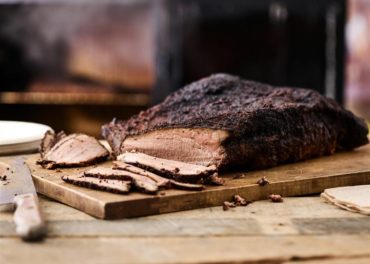Summer weekends are all about the barbecue. Grilling has become an American staple, and many home grill masters yearn to take it to the next level, impressing their friends and families with tasty, mouthwatering smoked beef. Smoking is a timeless technique that elevates the beef people crave by delivering rich flavor and tenderness.
What do you need to become a pit master? Here are the basics from the “Beef, It’s What’s For Dinner,” from the National Cattlemen’s Beef Association Culinary Center, funded by the Beef Checkoff.
Selecting Your Beef
Large cuts, such as brisket, roasts and ribs, are prime candidates for smoking, but even a beef burger can benefit from a hint of smoke. Some of the most popular cuts of beef for smoking are:
- Back ribs — a barbecue must, these ribs are flavorful and a great value.
- Brisket — this smoking classic is a fan favorite; sliced or shredded, can’t go wrong here.
- Rib-eye steak — rich and juicy, rib-eye is known for exceptional taste and generous marbling.
- Tri-tip roast — boneless and fairly tender, this rising star is growing in popularity.
Regardless of the cut you select, always remember that time, patience and practice pay off — don’t be afraid to tweak your technique to suit your tools and tastes.
Choosing a Smoker
Your smoker should fit your space, budget and preferred heat source. Here are a few options to consider:
- Kamado or ceramic smokers use lump charcoal and are very versatile, providing great heat retention and consistent high temperatures.
- Pellet smokers use an electric-powered auger to feed wood pellets into the smoker. They have a grilling area big enough for large cuts of meat.
- Electric gas smokers are great for beginners, making it easy to select and gauge temperatures.
- Charcoal smokers are favored for the low, slow cook many pit masters prefer. They offer a more natural flavor, but also need more temperature monitoring.
Picking the Right Wood
Once you’ve selected your smoker, you can further customize your smoking experience with different types of wood. Some variations to choose from include:
- Hickory is popular for smoking due to its strong, hearty flavor.
- Mesquite offers a very smoky flavor, great for cooking smaller cuts for shorter periods.
- Oak has a subtle flavor that’s great for larger cuts of meat.
- Apple smoke provides a sweeter taste.
- Pecan has a rich, sweet, nutty flavor.
- Cherry offers a hint of fruitiness.
- Maple leads to a sweet, mild smoky flavor.
Experimenting with different types of wood allows you to put your signature twist on beef’s craveable flavor profile.
Deciding on a Rub
Next up is creating a rub to complement the flavors provided by the beef and smoke. There are two main types of rubs to consider.
A dry rub typically starts with a base of sugar and salt and incorporates a variety of bold spices and herbs to create a flavorful crust on the outside of the meat.
Wet rubs contain wet ingredients, such as oil, vinegar, citrus juice, Worcestershire sauce or even molasses, combined with dry herbs and spices. One benefit of a wet rub is that the seasonings can have an easier time adhering to the meat.
When creating your rub, keep in mind your beef should always be the star of the show. Rubs play a supporting role by enhancing the great taste beef innately brings to a smoker.
Ready to put your skills to the test?
Try this recipe for Classic Smoked Beef Brisket from the chefs at the National Cattlemen’s Beef Association, a contractor to the Beef Checkoff, who develop recipes for BeefItsWhatsForDinner.com.
 Classic Smoked Beef Brisket
Classic Smoked Beef Brisket
Ingredients:
- 1 whole beef brisket (approximately 12-13 pounds)
- 1/4 cup granulated garlic
- 1/4 cup sweet paprika
- 1/4 cup cracked black pepper
- 2 tbsp kosher salt
Instructions:
Add wood chunks, chips, pellets or charcoal to smoker according to manufacturer’s instructions. Preheat smoker to 225 degrees.
Combine spices in small bowl. Press spices into brisket on all sides and edges.
Tip: Brisket may require trimming fat to ensure the rub makes contact with the beef.
Place beef on rack in smoker. Set timer for 12 hours.
Tip: To prevent dryness and accelerate the cooking process, try the “Texas Crutch” – wrap aluminum foil around the meat along with a little liquid, such as water, juice or beer.
Carefully remove beef from smoker after 10 and 1/2 to 11 hours or when temperature reaches 195 for beef that slices easily. For beef that can be shredded or chunked, carefully remove from smoker at 12 hours or when temperature reaches 205.
For more smoking recipes and tips, visit beefitswhatsfordinner.com/cooking/smoking-basics.


























